Samarkand - Bibi Khanum Mosque
Only four of the great buildings of that time have been preserved: the remains of the Ak-Saray Palace and the tomb of Amir Temur, the mausoleum of the Dorusiadat complex in Shakhrisabz, the mystical mausoleum of the Sufi-hoja Ahmad Yassawi in Turkestan and the ruins of a cathedral mosque in the capital Samarkand, known as the Bibi Khanum Mosque, which was to become the most magnificent mosque in the Muslim Orient.
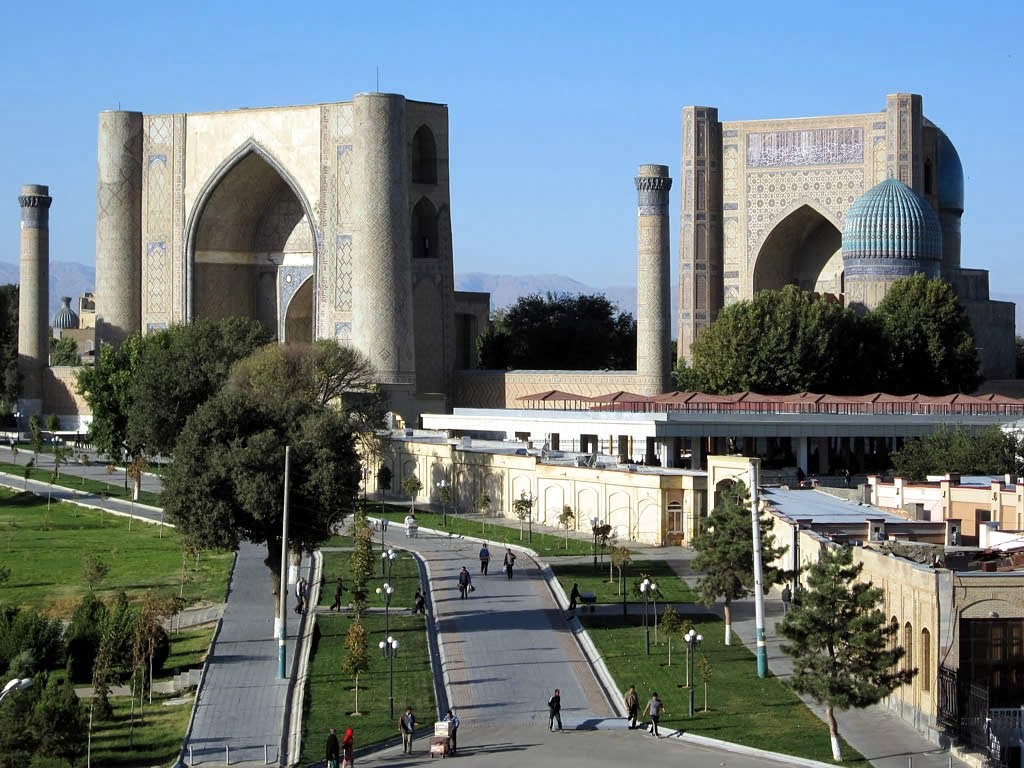
From the Afrosiab Hill the traveller can enjoy the panorama of an ancient city with a huge bazaar, behind which is the building of the XIV-XV century – the Bibi Khanum Mosque in Samarkand. The Jome Mosque occupied a special place in the life of the medieval town. It was a building of great public importance, embodying the feudal power of state and religion.
The Bibi Khanum Mosque in Samarkand (translated as “Elder Wife”, according to one of the legends it was built by Temur’s eldest wife, Saray-Mulk-Khanum) had a different name – Friday Mosque of Samarkand, where thousands of male Muslims came. Actually, the mosque was built in 1399-1404 by order of Amir Temur after his return from the Indian invasion. It was a time when the architecture of Central Asia developed a monumental style of façade construction, the directions of which correspond to the famous statement of Amir Temur: “If you doubt our power, look at our buildings”. The mosque was built in a short period of time – five years – by talented local masters and stonemasons from Azerbaijan, Persia, Khorasan and India. To ease the heavy work, 99 elephants from India were used.
To date 5 structures have been preserved: a portal; on the opposite side, in the depth of a courtyard, there are large mosques; on the sides – small mosques; a minaret. The enormous work of historians, archaeologists and art historians gives us the opportunity to present the original appearance of the mosque. One of the characteristic features of the architectural ensembles of this period is the enormous size and proportionality, the proportionality of the compositional parts of the ensemble, a beautiful example of which is Bibi Khanum.
It is a grandiose building, located on the area of a 167 x 109 m high slender portal 36 m high and 46 m wide, a spacious courtyard 54 x 76 m, a monumental main mosque, which stands on the central axis of the complex. The height and width of the main hall of the mosque is 41 m. With a portal span of 18 m. The inner courtyard was bordered by a gallery with 480 marble columns and pillars and bright small mosques. The buildings were constructed of 27x27x5 cm bricks on a gangway. The entrance to the mosque was decorated with two wing gates made of seven-alloy, carved marble slabs and the richest decoration.
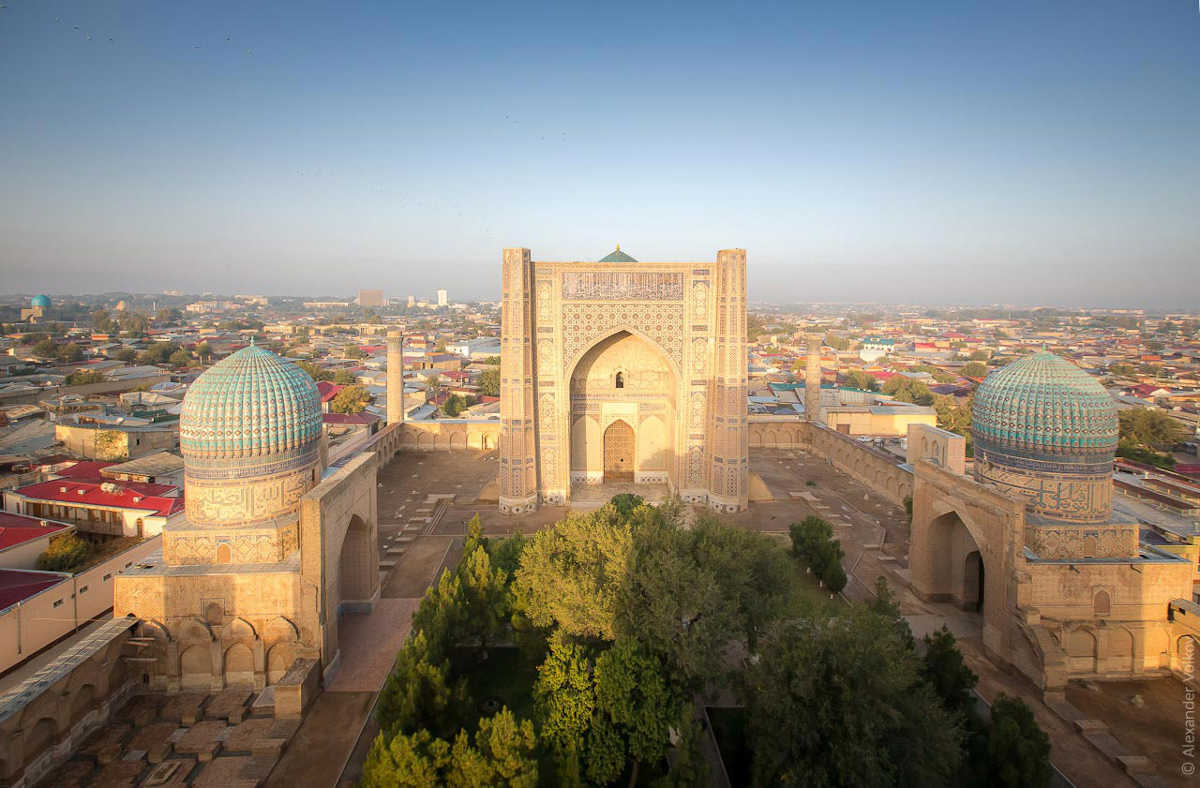
In the middle of the courtyard there is still a marble desk, which was made for the Holy Quran in gigantic sizes by Ulugbek. On the edges of the court there were minarets about which one of the Temur historians wrote: “The minaret raised its capitol to heaven and wept: ‘Verily, our deeds point to us’. About the dome of the mosque it was written even then: “Its dome would be the only one if the Milky Way was not a pair with it”.
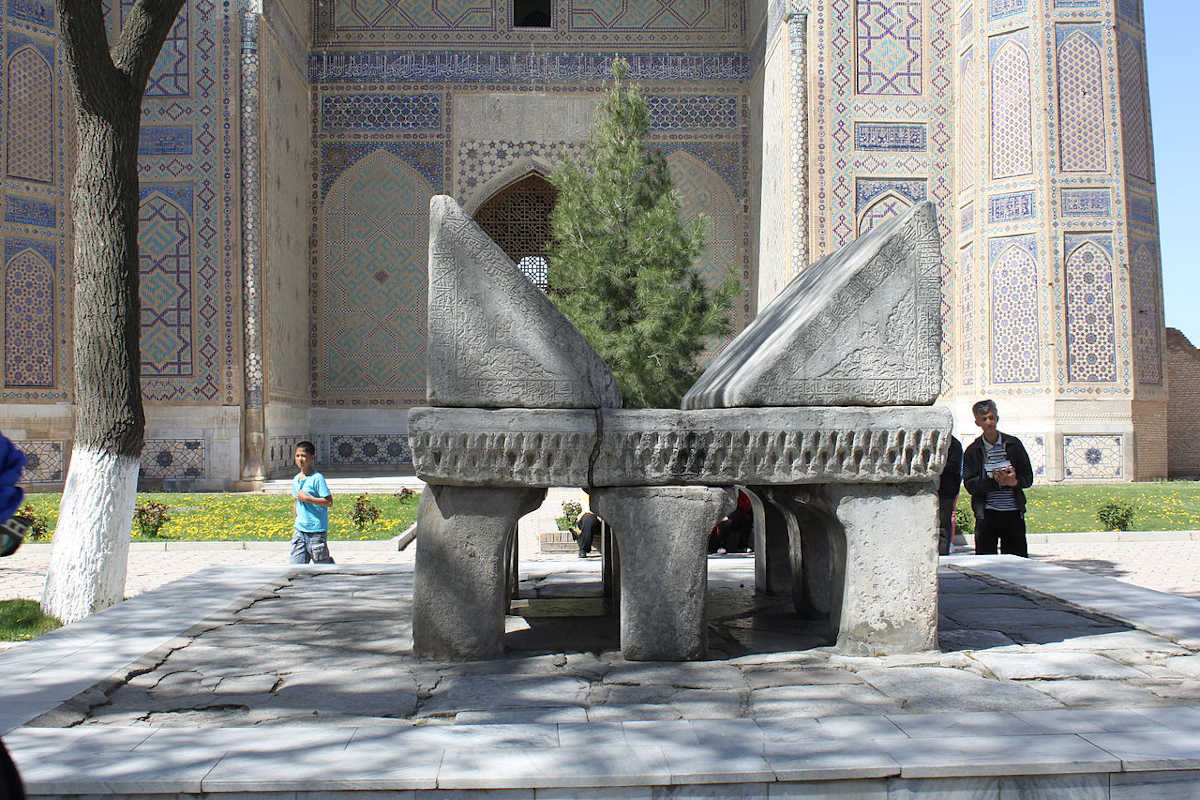
It is remarkable that the dome of the mosque, which could be seen for many kilometres from the main entrance when approaching Samarkand, is not visible, as the height of the dome corresponded to the height of the portal.
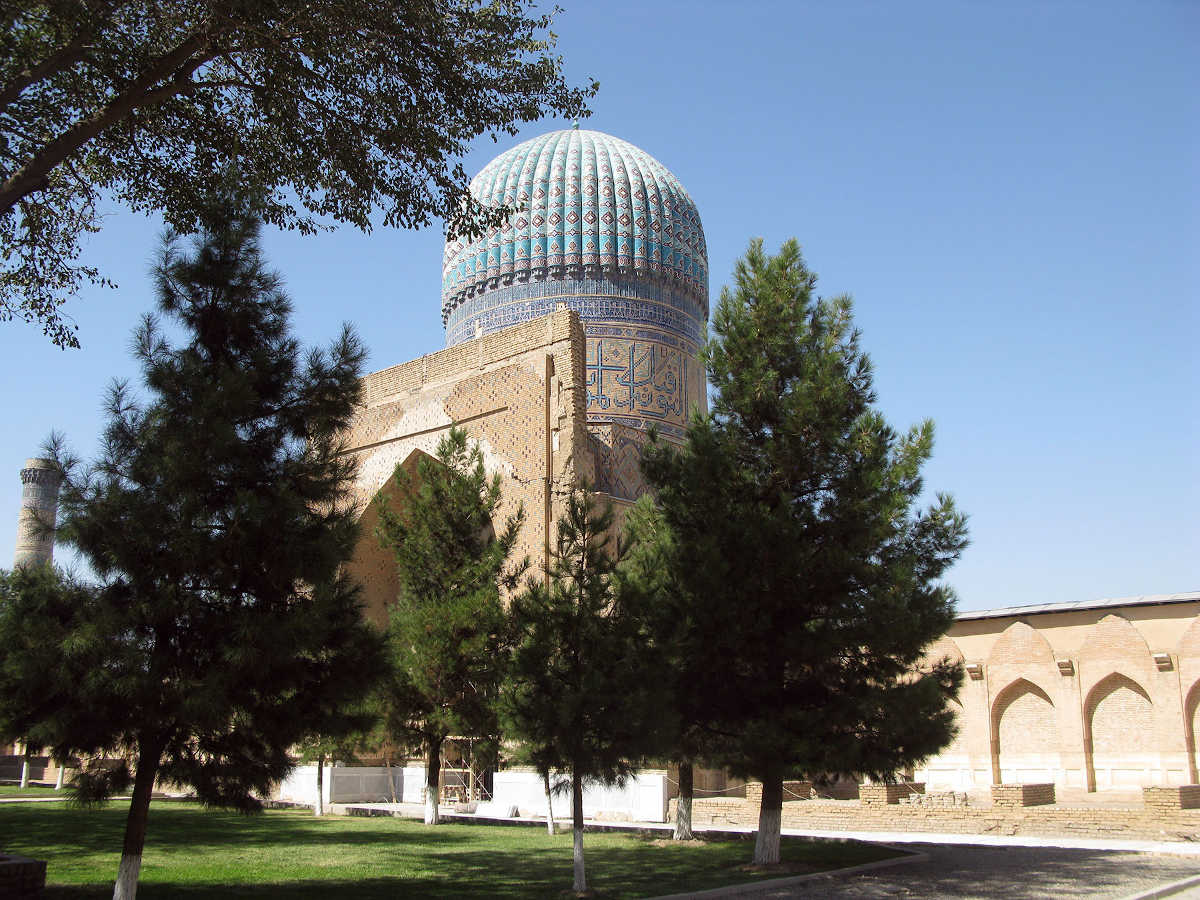
The construction of the large mosque is executed in mayolica technique in combination with non-rigid bricks and carved, framed mosaic, decorated with the finest plant, geometric and epigraphic ornaments. The interior of the mosque was decorated with plaster paintings on the walls and gilded papier-mâché on the inside of the dome. The external decoration of the small mosques is inferior to that of the large mosque. This is an architectural technique whose purpose is to emphasise the dominant importance of the main building.
The decoration of the building has concentrated all the best that the masters achieved until the beginning of the XV century: Mayolica and carved mosaics, carved marble, carved wood, painting on the plaster and decoration in papier-mâché. This was a new stage in the development of traditional medieval mosques. The innovation of the master builders is also reflected in the pursuit of maximum aesthetics of form. Amazingly many things – double, raised on the drums of the domes, sharp points of the minarets, high portals, towers, elegant marble columns of the gallery with a vaulted ceiling. There is an introduction of the vertical as the most important element of architecture.
The mosque was built on a large scale, but without taking into account earthquakes with such increase in size. In spite of the deep foundations of the broken stone, huge masses of brick masonry in the walls, the thickness of which reaches five metres, began to fall down stones from the cracked dome already during Timur’s lifetime.
East of the mosque, on the opposite side of the street, there is an original monument – an octahedral, columnar mausoleum Bibi Khanum with a crypt. This building has no main façade; it was probably added to Bibi Khanum Madrasa.
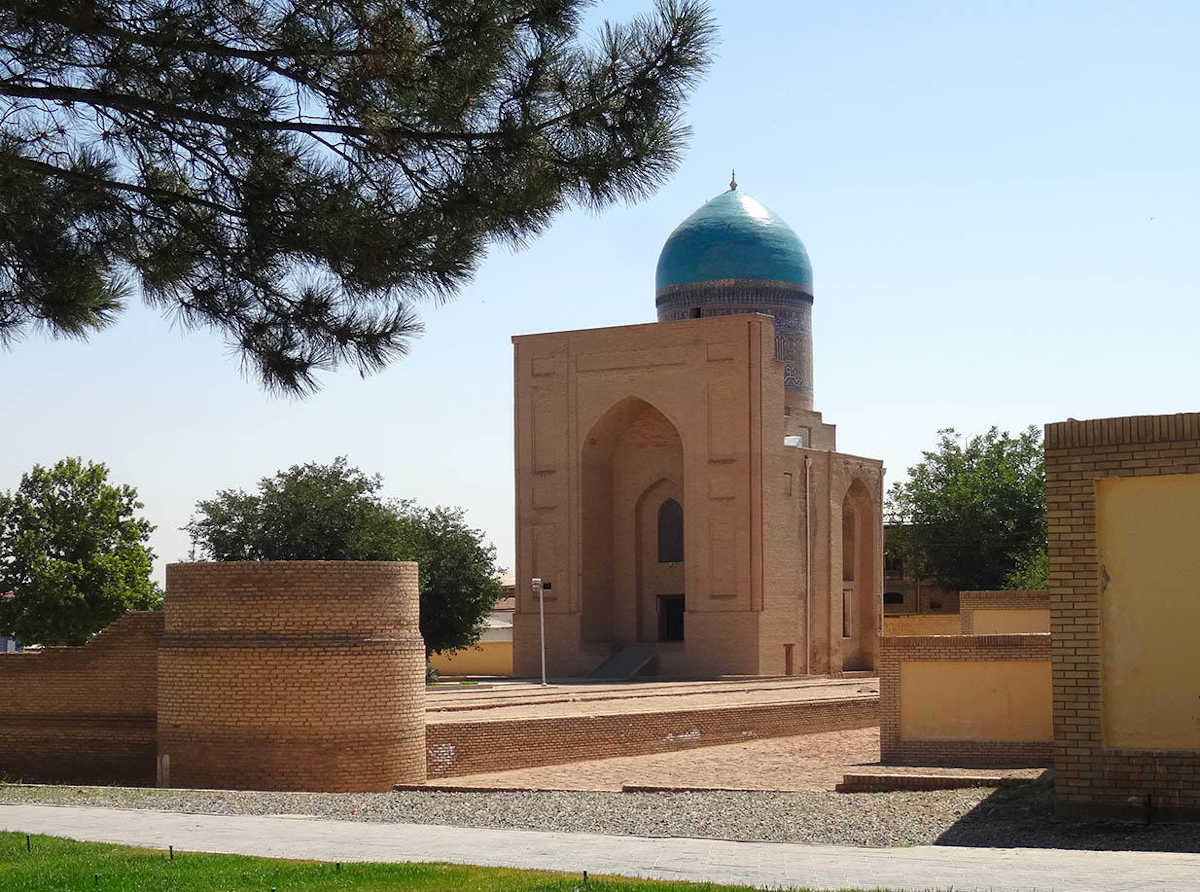
The decoration of the mausoleum shows that it was built simultaneously with the mosque. In a spacious crypt on the floor there are marble sarcophagi. When it was opened in 1941, the remains of two other middle-aged women in rich clothing were found. It is possible that one of them was the Saray Mulk Khanim. A poetic legend about the construction of the Bibi Khanum mosque has been preserved until today.
The beautiful Bibi-Khanum, wife of Timur, was to surprise and delight her husband. When the ruler was absent during one of the numerous military campaigns, she called the best builders and masters of Samarkand to the palace and offered them to build the structure. The work started immediately. The walls grew quickly.
Meanwhile, Samarkand received news of Timur’s imminent return. Bibi Khanum constantly overreacted. Then the master builder made the condition: “The mosque will be built on time, but… you, Her Majesty, will give me a kiss”.
The Ruler was outraged: “I will give you any of my slaves of your choice. Why do you only look at me? Look at the painted eggs, they are of different colours and do not resemble each other at all, but when you break them, do they differ in any way? That is how we women are”.
But the architect insisted: “I want to answer you. Here are two identical glasses. One of them I fill with clear water, the other with white wine. And now they resemble each other, but when I touch them with my lips, one of them burns me with liquid fire and the other one I will not feel. It is love.”
Temur approached in Samarkand. The anger of Bibi Khanum had no limits. For so long the treasured surprise was in danger for the ruler. Besides, as legend has it, the master builder was young and handsome. And she agrees. At the last moment she tried to cover herself with her palm. But the kiss was so passionate that its heat penetrated the hand of beauty and left a fiery red stain on her cheek.
Only a few days later Temur had come to town. Domes and minarets rose before his eyes and amazed with their splendour. But his joy was overshadowed. When he saw the sign of the kiss on Bibi Khanum’s face, he went into a rage. Bibi Khanum confessed everything. By order of the “Iron Lame” the guards hurried to find the architect. Fleeing from persecution, he and his pupil climbed up the minaret of the mosque.
And when the guards ran up the countless steps behind them, they found only one student. “Where is the master builder?” – they asked – “The teacher made wings and flew to Meshhed,” he replied. That is a legend.
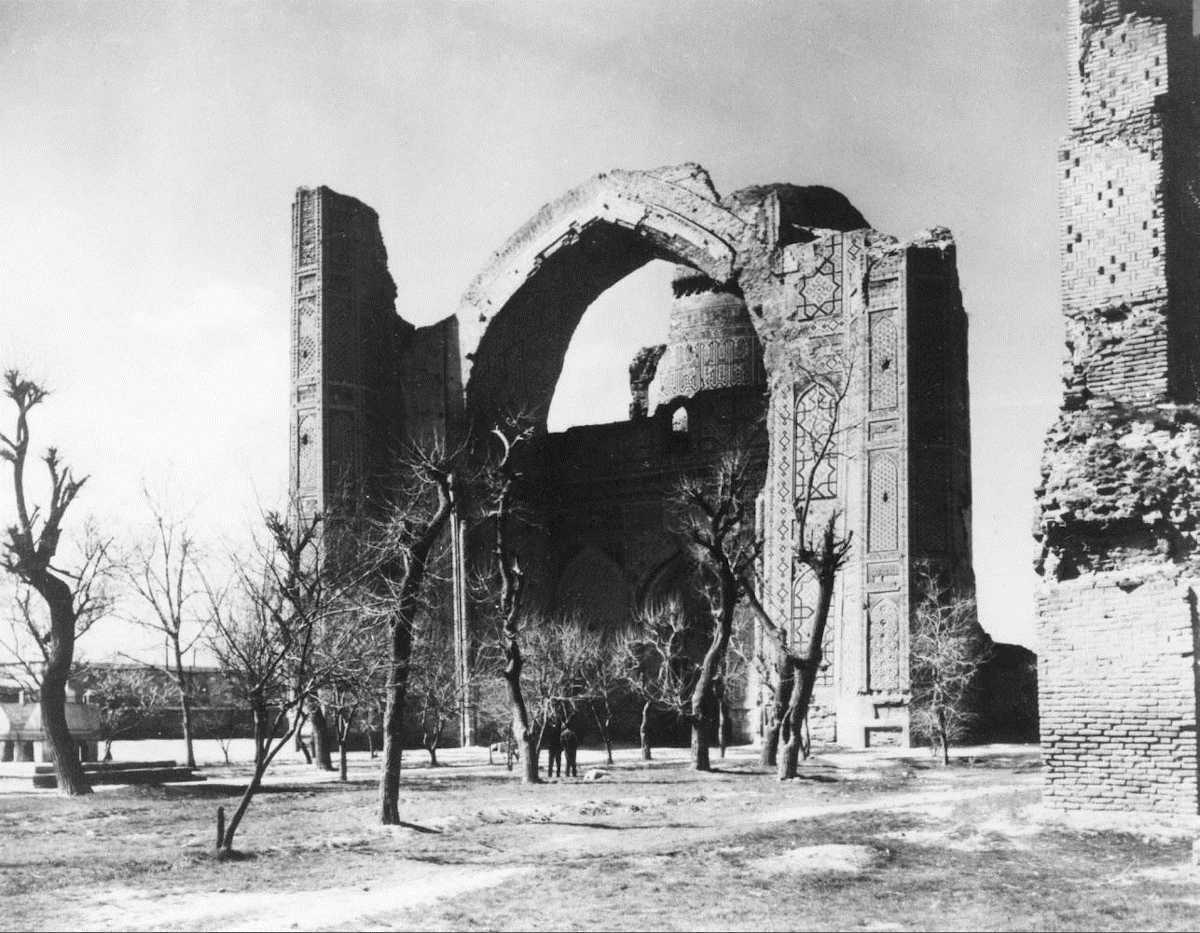
At the beginning of the XX century, the Bibi Khanum mosque was a destruction and majestic ruin, time was hard on the Friday mosque. But even these ruins leave an indelible impression. From the 1960s to the present day, as a result of restoration and grandiose works, the inner and outer domes were built, the vault of the portal and the base of the walls were reinforced, the interiors of small mosques were restored and minarets were rebuilt. The works are in progress. The Bibi Khanum Mosque in Samarkand is an immortal masterpiece of architecture in the Muslim Orient.
